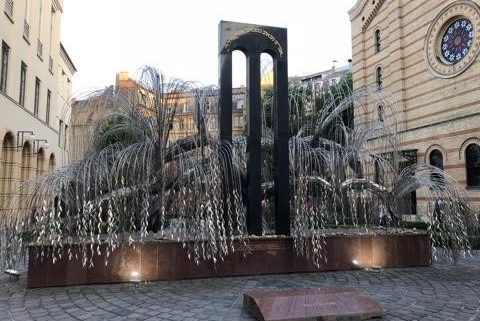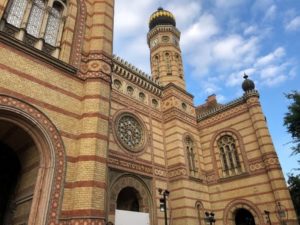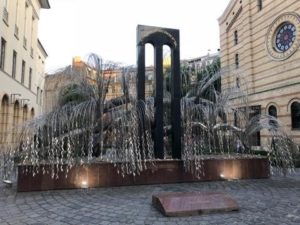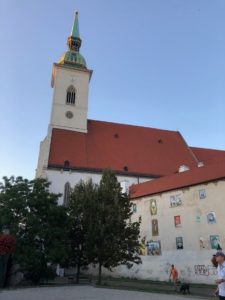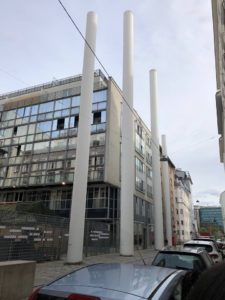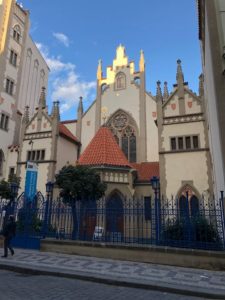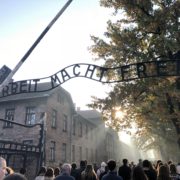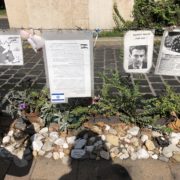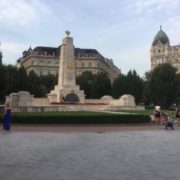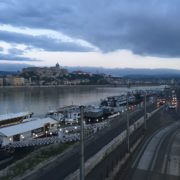Looking at Central Europe Through Its Synagogues
By Ciera Moore
The influence of Jewish culture and religion is apparent all throughout Europe to this day, despite the efforts of the Nazi regime to destroy it. Even if there were no remaining synagogues or religious places, there are monuments commemorating the victims of the Holocaust. Every city we visited in Europe thus far has paid tribute to the Jewish life that existed prior to World War II. While some countries claim victim-hood and deny their involvement in the destruction of local Jewish communities, the truth can be seen through the perspective of the survivors and those that wish to remember the horrors that occurred within their country. The remaining synagogues throughout Europe also tell a history that is impossible to erase and should instead be embraced as a reminder of our humanity.
The largest synagogue in Europe, the Dohány Street Synagogue, located in Budapest, Hungary, happened to be a mere few hundred meters from where we stayed. This synagogue, built in the late 19th century, was damaged in 1939 by the Arrow Cross Party and was used by the Nazis during WWII until it was destroyed during the Siege of Budapest. It wasn’t until the early 1990s that it underwent a reconstruction. The Dohány Street Synagogue was completed in the late 1990s and reopened to the public. The casual observer wouldn’t know that inside is a graveyard. They also probably wouldn’t know that synagogues don’t traditionally have graveyards. However, this graveyard is the final resting place for almost 2,600 Jewish people that died in the surrounding ghetto from disease, hunger, or other means. This is because the main Jewish cemetery was located outside of the ghetto and there was no other final resting place that belonged to the community. These people are remembered through commemorative stones that contain their name, year of deportation if they went to a concentration camp, and year of death. the sculpture titled
Memorial of the Hungarian Jewish Martyrs is another way in which this synagogue remembers the Hungarian Jews who lost their lives during WWII. The silver weeping willow is a representation of the over 400,000 Hungarian Jews that died during the Holocaust. There are names inscribed on many of the leaves commemorating them. Any passerby can gaze upon this memorial and remember those that otherwise might have been forgotten.
There is one remaining synagogue in the entire city of Bratislava, Slovakia and it was built between 1923 and 1926. Prior to WWII there were multiple functioning synagogues, but all were destroyed in 1969. In 1961, the Orthodox synagogue was destroyed and in 1969 the Neolog Synagogue was demolished, along with the Judengasse. The Judengasse was the street that served as the main residence for Jews in Bratislava. They weren’t allowed to live outside of the confines of this street. The Neolog Synagogue was demolished due to the construction of the SNP Bridge. Our guide, Ľubica Voľanská, told us that the city had a decision to make regarding the construction of the SNP Bridge. They either had to knock down the Neolog Synagogue or St. Martin’s Church. The people at the time wished for visitors of Bratislava to see a church upon entering the city, so a unanimous decision was reached to demolish the synagogue. Most of the Jewish population in Bratislava was killed during the Holocaust, so to this day the Jewish population is small in comparison to other European cities. The lack of Jewish memorials in Bratislava is startling. I suspect they may be behind in acknowledging their history because to this day they are struggling with racism
against the Roma and refugees. Many Slovaks won’t acknowledge the citizenship of Roma, and both minorities are often denied admittance into schools and state jobs. With the amount of discrimination apparent today, it doesn’t surprise me that Slovakia is having a difficult time dealing with remembering the Jews of the Holocaust and how they dealt withdiscrimination in the past.
Vienna, Austria has its own story to tell of Nazi occupation and the persecution of its Jews. The largest synagogue in Vienna, the Leopoldstadter Temple, was built in the late 19th century in the second district in Vienna. Just like others during WWII, this synagogue was set on fire and destroyed during Kristallnacht, the Night of Broken Glass. Our guide, Marianne
Windsperger, informed us that in most cases, the local people within the community were held responsible by the authorities to clean up such destruction. In the place of the Leopoldstadter Temple today is a memorial consisting of four pillars. These pillars provide an insight into the shape and size of the synagogue as it once was. Without being aware of its history however, you wouldn’t realize that the pillars hold such significance for the Jewish community. Thankfully, there is information provided to the viewer about the events that transpired there. Vienna is filled with other memorials dedicated to the Jews that lost their lives, but many remain hidden; to find them, you must go exploring to locate some of them, especially this one, which we found thanks to our tour guide.
The synagogue in Prague that I want to focus on is the Maisel Synagogue. Built in the 16th century by a rich Jewish family, this synagogue is designed in the style of a church.
According to our guide, at that time, the only architects in Prague were those who built churches, which is why the Maisel Synagogue resembles a church in its architecture, and not a traditional synagogue. During the time, the surrounding area of the synagogue was considered the Jewish ghetto, so this building was the most lavish and expensive of them all. Due to his high standing in society, while Maisel was still alive this synagogue was strictly for his family. After his death, he bequeathed the synagogue to the Jewish community for everyone to use. It went on as such until WWII when, after the entire Czech Jewish population was forcibly evicted to concentration and death camps, the Nazis used the synagogue as a storage facility. The buildings surrounding it now, while still considered the Jewish quarter, are much nicer than the previous ghetto after having been rebuilt in the 1900s. Today, this synagogue is a part of the Jewish Museum in Prague and pays tribute to the city’s Jewish history.
Synagogues throughout Europe can tell us history from a different, non-mainstream, perspective. It is important to go to each European city impacted by the Holocaust and see how the events transpired from the point of view of the Jewish community. The non-Jewish citizens of Czechoslovakia, Hungary, and Austria were in large bystanders or also contributors to the persecution of the Jews and Roma. So, history told through these countries that name themselves as victims of WWII will most likely tell an inaccurate history. For example, Austria claims victimhood during the Holocaust, when they actually welcomed Hitler and encouraged the persecution of the Jewish population. Told solely from this point of view, we wouldn’t get the full picture of death and destruction. That is why it is crucial for tourists and students to learn about the Jewish experience before, during, and after the war. Everyone who died during the Holocaust were people who lived everyday lives. They were just like you and me. They had families, jobs, and pets. After the war, the way of life of European Jews was completely destroyed. By visiting these synagogues and listening to their history, you can picture the way life used to be, and how it was so cruelly taken away. To remember and acknowledge that these horrific events took place is one step towards ensuring that it never happens again.

